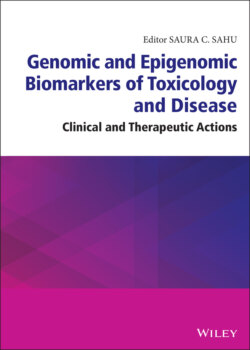Читать книгу Genomic and Epigenomic Biomarkers of Toxicology and Disease - Группа авторов - Страница 24
Mechanisms that Contribute to Extracellular miRNA Release
ОглавлениеWhen using the miRNAs present in biofluids as biomarkers of tissue perturbation, toxicity, or disease, one must understand the origin of these non-coding RNAs in the extracellular space. Most studies have focused on the miRNAs found in blood and urine, although extracellular miRNA has been noted in sputum, tears, amniotic fluid, cerebrospinal fluid, breast milk, and bronchial lavage fluid, among other sites (Arroyo et al. 2011; Chen et al. 2008; Turchinovich et al. 2011; Valadi et al. 2007; Vickers et al. 2011; Wang et al. 2010a; Weber et al. 2010). Although many miRNAs seem to be ubiquitously present in many characterized biofluids, blood plasma has the highest amount of uniquely present miRNAs (Weber et al. 2010). Blood is a complex liquid “tissue” that interacts with many cell types not accessible to other fluids, including those of hematopoietic residence—predominantly erythrocytes and reticulocytes. The contributions from these cell types are important to characterize, so that they can be separated, if needed, from the signals of other cell types or tissues. For example, in whole blood samples, miRs-486-5p and -451a are highly represented because they are derived from erythrocytes and can complicate or mask the evaluation of other putative biomarker miRNAs of lower abundance in the blood (Juzenas et al. 2020). Mechanistically, these potentially interfering factors can be removed by processing blood into serum or plasma, or, in cases where hemolysis may increase the proportion of erythrocyte-derived miRNAs in serum, blocking steps can reduce the measurement of these miRNAs (LaBelle et al. 2021).
Extracellular miRNAs are released by their cells of origin through a number of different mechanisms, which can simply be classified into “active” and “passive” release (Harrill et al. 2016). Those that are passively released are due to mechanisms of plasma membrane breakdown that lead to the spilling or “leaking” of intracellular contents into proximal biofluids. This can occur with cell death, necrosis, or toxicity. Importantly, some miRNAs have cell- or tissue-specific expression (Bailey and Glabb 2018). As such, these biomarkers may indicate specific tissue damage or disease. A number of studies have demonstrated the specificity of miRNAs and other non-coding RNAs for different tissues in clinical and non-clinical species such as human (miRNA TissueAtlas: Ludwig et al. 2016), rat (RATEmiRs database: Bushel et al. 2018; Smith et al. 2016), mouse (Isakova et al. 2020), and dog (Koenig et al. 2016). According to various analyses of these resources, those considered tissue-specific ranged from ~ 100 to ~ 400 miRNAs, depending on the species, and there was noted overlap among mammals that indicated putative biomarkers that could be used for cross-species profiling (Figure 2.1).
